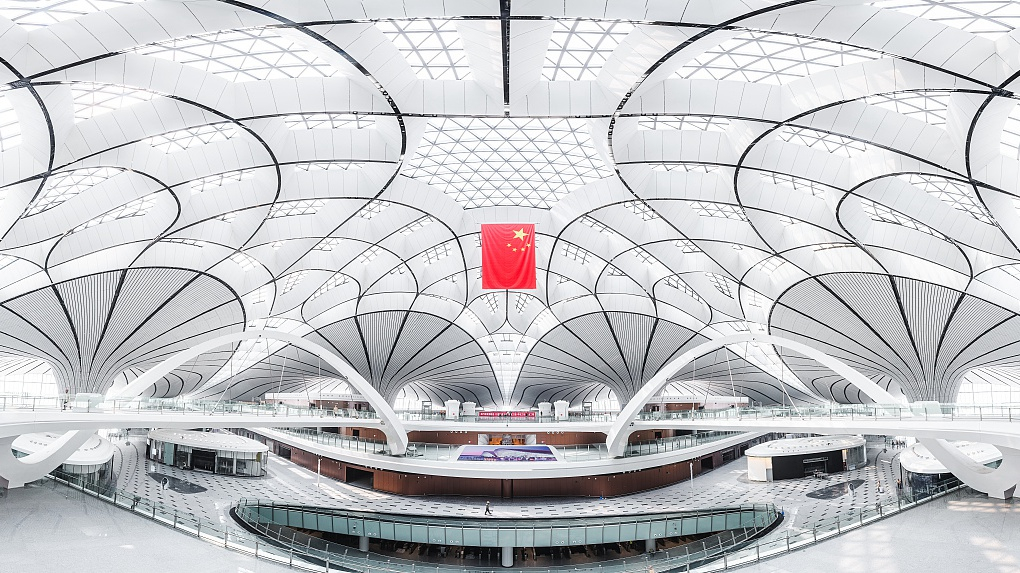
Editor's note: Tom Fowdy graduated from Oxford University's China Studies Program and majored in politics at Durham University and writes about international relations focusing on China and the Democratic People's Republic of Korea. The article reflects the author's opinions, and not necessarily the views of CGTN.
Beijing is one the largest cities in the world. With a municipality population of over 21 million, the pressure has been constantly on Chinese authorities to develop an infrastructure that's capable of facilitating its rapid economic development and its rise in importance as the country's scientific, educational and political center. In doing so, the city has been traditionally serviced by two airports: Beijing Capital Airport (PEK) and Beijing Nanyuan Airport (NAY), the former of which is the second busiest airport on Earth.
In order to accommodate the city's surging air traffic and number of passengers, a change was required. Thus for many years authorities began planning the emergence of a new super-sized airport to replace the smaller and aging Nanyuan. Now this September, that change has finally come to fruition in the form of the newly completed Beijing Daxing International Airport (PKX), situated to the south of the city. At a size of over 11 million square feet, its terminal is one of the largest on Earth, with a designed capacity to handle up to 100 million passengers annually. Opening on September 30, tickets for the first commercial flights officially went on sale on September 19.
The new airport is a headline display as to how China utilizes investment in infrastructure as its primary means of securing economic growth and development. In contrast to laissez faire approaches in Western countries which base growth upon unregulated market forces (and can subsequently neglect infrastructure), China is able to lead the economy through strategic investments which amplify economic opportunities in given areas, allowing the country to see through turbulence. The new airport will subsequently facilitate a change in Beijing's international importance in the world of aviation, transforming it into a new hub for long haul travel and allowing it to compete with Seoul and Tokyo accordingly.

The Chinese Garden in Beijing Daxing International Airport, China, August 17, 2019. /VCG Photo
The Chinese Garden in Beijing Daxing International Airport, China, August 17, 2019. /VCG Photo
The Chinese government has long viewed infrastructure as the primary means of securing the country's economic development. Why? Because economic opportunities and in turn, jobs, business and growth cannot happen without the necessary conveniences of infrastructure. Infrastructure is the catalyst that makes the development of market forces possible. Cities must be linked and people must be brought together more easily and swiftly. As a result, the country has assembled the world's largest high-speed rail network which has linked locations as far apart as Beijing and Hong Kong.
This strategy of growth is remarkably different from some Western countries, which allocate more responsibilities in the economy to the market on its own, with minimal state investment and support.
In Britain, this strategy has been disastrous, and is a key cause of the country's low growth besides Brexit. While China for example has the world leading, advanced high-speed rail infrastructure spanning and connecting the whole country, the British system which is managed by private sector companies seeking only profit (and not collective development) is limited, slow, overcrowded and extremely overpriced. The United Kingdom has fallen staggeringly behind China in terms of infrastructure.
In this case, China is able to sustain and perpetuate economic growth through persistent and competitive infrastructure investment, which can also see off times of uncertainty such as the trade war. This leads us to the new Daxing Airport. It is a game changer for Beijing. A new mega airport (and thus two large airports) will increase the city's overall passenger capacity and in turn amplify the number of available flight paths and routes.
With Beijing already being a cheaper location to transit through than Seoul and Tokyo, this now gives the former the lead in securing competitive inter-continental transfer routes between Asia and North America. Given this, the commencement of Daxing Airport is likely to transform Beijing into the center of global aviation.
Thus, as a whole, while foreign powers have repeatedly criticized China's bid to assist other nations in infrastructure development, the rapid advancement in China's domestic infrastructure at home is a demonstration as to why these claims are wrong, sensational and misleading. When other developing countries followed the Western laissez faire model in the 1980s (as per IMF demands), they suffered catastrophic decline, because the presence of market forces, and thus investment, cannot exist save you first have the necessary infrastructure to make their business possible, worthwhile and convenient.
In this case, Beijing Daxing International Airport is a marked demonstration of what China is capable of and how the development of superior infrastructure will ensure the country's future growth, all while the transport infrastructure of Britain, America and other English speaking countries continues to fall further and further behind.
(If you want to contribute and have specific expertise, please contact us at opinions@cgtn.com.)